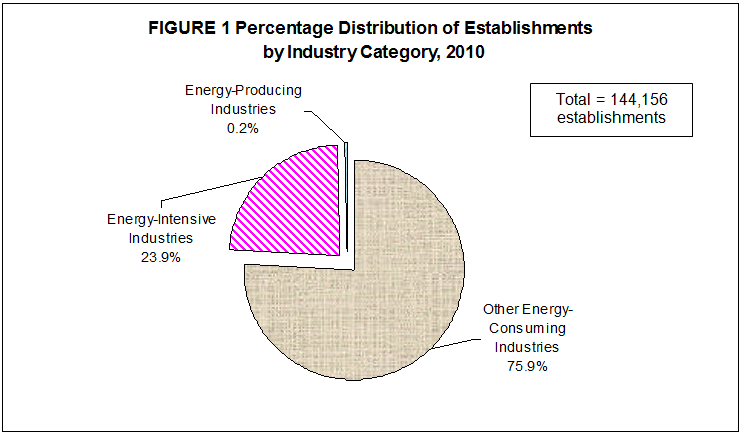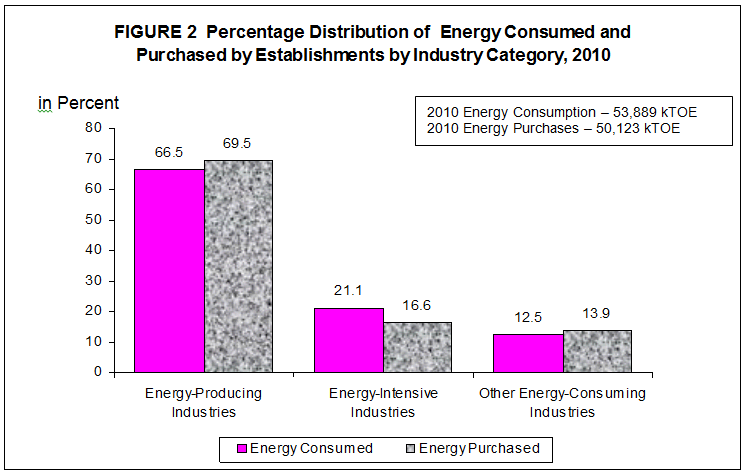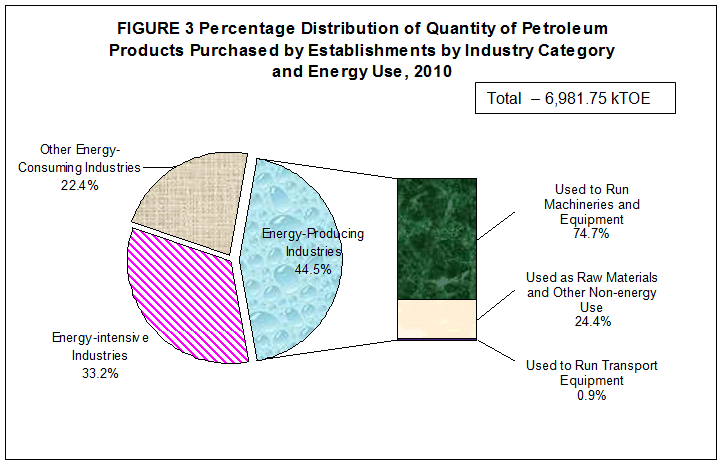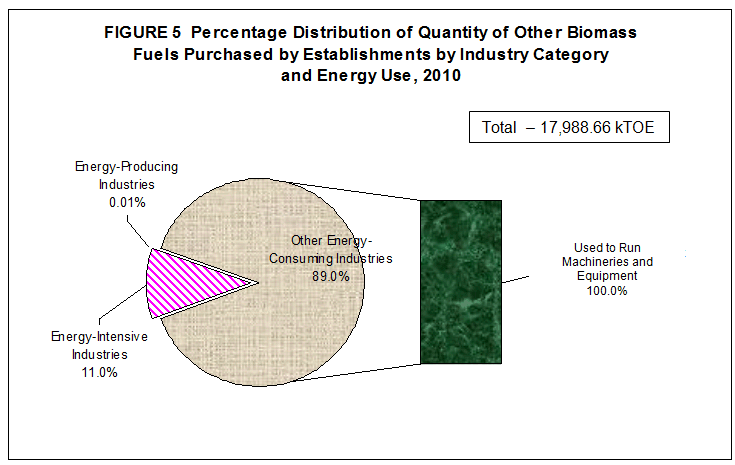2010 Survey of Energy Consumption of Establishments (SECE) - FINAL
Final Results
2010 Survey of Energy Consumption of Establishments (SECE)
All Establishments
For the purposes of this report, industries are categorized into two, namely Energy-producing industries and Energy-consuming industries.
Energy-producing industries are those industries involved in the extraction of crude, coal, and natural gas and production of petroleum products,electricity and renewable energy such as charcoal, biogas, and biofuel. On the other hand, energy-consuming industries are industries using energy from different energy sources in their business operations.These are further categorized as energy-intensive industries and other energy-consuming industries.
Energy-intensive industries are those industries with high consumption of electricity and fuels. NSO utilized the results of the 2008 Annual Survey of Philippine and Industry, which was the latest available data at the time of the survey, to identify energy-intensive industries as follows:
Industries with consumption of electricity, water, fuels, lubricants, oils and greases amounting to at least 20 percent of the total cost of input of that industry
Industries with consumption of electricity, water, fuels, lubricants, oils and greases amounting to at least 10 percent of the total consumption of electricity, water, fuels, lubricants oils and greases of the section
The Department of Energy also identified some industries as energy intensive.
The remaining industries and sections are classified as Other energy-consuming industries. These are industries with consumption of electricity, water, fuels, lubricants, oils and greases amounting to less than 20 percent of total cost of input of that industry and less than 10 percent of the section’s total intermediate cost incurred in 2008.
Number of Establishments
Survey results revealed that there were 144,156 establishments covered in the 2010 SECE, of which three-fourths (75.9%) consisted of Other energy-consuming industries, and 23.9 percent were Energy-intensive industries. Only 0.2 percent or 341 establishments were Energy-producing industries (Figure1).

Presented hereunder are statistics on energy consumption and purchases of establishments by industry category and energy use in 2010. The change in inventory constitutes the difference between consumption and purchases.
The energy data expressed in their original units are converted to tons of oil equivalent (TOE) in order to sum up all energy forms. Quantity of energy is expressed in kilo Tons of Oil Equivalent, kTOE. This is the amount of energy equivalent to that which is contained in 1000 tons of oil.
Total Energy Consumption
Overall energy consumed by establishments in 2010 was recorded at 53,889.59 kTOE. This number comprised consumption for Fossil Fuels with 31,634.23 kTOE (58.7%); Renewable Energy with 19,118.70 kTOE (35.5%); and electricity with 3,136.67 kTOE (5.8%).
Of the total energy consumed in 2010, two-thirds (66.5%) or 35,813.16 kTOE were consumed by Other energy-consuming industries, 21.1 percent or 11,350.83 kTOE by Energy-intensive industries, and 12.5 percent or 6,725.60 kTOE by Energy-producing industries.
On the other hand, of the total quantity of energy products purchased in 2010 (Table 2), 69.5 percent (34,836.96 kTOE) were purchased by Other energy-consuming Industries; 16.6 percent (8,305.00 kTOE) by Energy-intensive industries, and 13.9 percent (6,981.51 kTOE) by Energy-producing industries (Figure 2).

I. Fossil Fuels
Petroleum Products
Total quantity of energy consumed for petroleum products which include gasoline, diesel fuel, bunker oil, kerosene, LPG/auto LPG, AVGAS, AVTURBO, andasphaltin 2010 totaled 6,917.21 kTOE, of which 44.3 percent (3,062.98 kTOE) were consumed by Energy-producing industries, 33.3 percent (2,303.22 kTOE) by Energy-intensive industries, and 22.4 percent (1,551.01 kTOE) by Other energy-consuming industries.
Among Energy-producing industries (Figure 3), 74.7 percent (2,319.11 kTOE) of petroleum products were purchased to run machineries and equipment, 24.4 percent (758.05 kTOE) as raw materials and other non-energy use, and 0.9 percent (28.02 kTOE) to run transport equipment.

Coal
Total quantity of Coal consumed by establishments in 2010 reached 23,600.59 kTOE of which about 66.0 percent (15,565.18 kTOE) were consumed by Other energy-consuming industries, 19.8 percent (4,662.39 ktOE) by Energy-intensive industries, and 14.3 percent (3,373.02 kTOE) by Energy-producing industries.
Of the total quantity of Coal purchased in 2010 (Figure 4), 74.1 percent (14,860.43 kTOE) were purchased by Other energy-consuming industries, 17.9 percent (3,587.93 kTOE) by Energy-producing industries, and 8.0 percent (1,612.77 kTOE) by Energy-intensive industries.
Almost all quantity of coal (99.8% or 14,837.46 kTOE) purchased by Other energy-consuming industries were used to run machineries and equipment, and only 0.2 percent or 22.97 kTOE were used as raw material and for other non-energy use.

Natural Gas
Recorded quantity of Natural gas consumed by establishments in 2010 was approximately 1,116.42 kTOE.All natural gas purchased in 2010 (1,115.22 kTOE) was used by Energy-intensive industries to run transport equipment.
II. Renewable Energy
Fuelwood
Aggregate Fuelwood consumption of establishments in 2010 was registered at 691.31 kTOE, of which about 98.6 percent or 681.58 kTOE were used by Other energy-consuming industries and only 1.4 percent or 9.73 kTOE by Energy-intensive industries. All fuelwood purchased (780.69 kTOE) in 2010 was used to run machineries and equipment.
Charcoal
Recorded total quantity of charcoal consumed in 2010 was about 60.09 kTOE, of which 55.2 percent or 33.16 kTOE were used by Other energy-consuming industries and 44.8 percent or 26.93 kTOE by Energy-intensive industries.All charcoal consumed in 2010 was used to run machineries and equipment.
Other Biomass
Consumption of Other biomass fuels (bagasse; biogas; sawdust; rice stalk, and hull; coconut shell, and husk; corn cob, stalk, and husk) by establishments in 2010 summed up to 18,367.30 kTOE.
Of the total quantity of Other biomass fuels consumed in 2010, 89.2 percent or 16,387.41 kTOE were utilized by Other energy-consuming industries, 10.8 percent or 1,977.15 kTOE by Energy-intensive industries, and only about 0.01 percent or 2.74 kTOE by Energy-producing industries. All Other biomass fuels purchased (17,988.66 kTOE) by Other Energy-consuming industries in 2010 were used to run machineries and equipment (Figure 5).

III. Power Sector
Electricity Consumption by Source
Total quantity of electricity consumed by establishments in 2010 reached 3,136.67 kTOE. Bulk of electricity consumed (79.5% or 2,493.85 kTOE) was sourced from Distribution Utilities or Electric Cooperatives. Electricity produced and consumed (self-generated) by industries amounted to 419.68 kTOE (13.4%) while 179.44 kTOE (5.7%) of electricity were purchased from Wholesale Electricity Spot Market (WESM). Around 1.4 percent (43.71 kTOE) came from other sources.
Of the total quantity of electricity consumed, 50.8 percent or 1,594.82 kTOE were utilized by Other energy-consuming industries. Energy-intensive industries consumed 40.0 percent (1,254.99 kTOE) and Energy-producing industries, 9.2 percent (286.86 kTOE).
Among Other energy-consuming industries, 85.0 percent (1,355.82 kTOE) of electricity consumed in 2010 came from Distribution Utilities or Electric Cooperatives; 11.1 percent (176.94 kTOE) were self-generated; 2.9 percent (46.24 kTOE) was purchased from WESM; and 1.0 percent (15.81 kTOE) was purchased from other sources.
Technical Notes
The 2010 Survey of Energy Consumption of Establishments (SECE) is the first-ever survey of establishments on energy consumption. It is the counterpart of the Household Energy Consumption Survey (HECS) - conducted to monitor energy consumption of households. So far, four HECS were undertaken in 1989, 1995, 2004 and the latest was in 2011.
Like the HECS, the 2010 SECE was conducted in collaboration with the Department of Energy (DOE). DOE is the major data user of the 2010 SECE results. Hence, DOE and its attached agencies were consulted in the determination of data items to be collected and the indicators to be generated for the 2010 SECE.
The 2010 SECE was conducted in 2011 with 2010 as reference year.
Uses of Survey Data
The data gathered from the 2010 SECE aimed to provide benchmark information on the country’s energy utilization patterns of industries, generate indicators of energy intensities of industries, measured as energy consumption per unit output and highlight energy-producers and energy-intensive users among the country’s industries.
Among others, the survey also generates data on:
- quantity of fuels purchased by type such as petroleum, other fossil and biomass fuels classified according to usage
- quantity and value of electricity purchased by source
- quantity of electricity generated for own-use and quantity of fuels consumed
- quantity and value of electricity produced, and the quantity and value of fuels consumed by electricity generating establishments
- energy consumed by transport vehicles
- electricity consumption of air-conditioning units, lighting fixtures, appliances, and equipment/machineries
- energy related information about the establishments such as total production and floor area
- beginning and ending inventories by type of fuels.
Sampling Design
The sampling design of the 2010 SECE utilized stratified systematic sampling with 5-digit PSIC code (industry sub-classes) serving as industry strata and employment size as the second stratification variable. Energy-producing industries were covered on a hundred percent basis and energy- consuming industries, on a sampling basis.
Energy intensive industries with Total Employment of 20 and over were covered on a 50% basis and those with less than 20, 25 percent.
For energy intensive industries identified by DOE, all those with TE of 100 and over were covered and the rest, on sampling basis.Sugar milling and cement manufacturing establishments identified by DOE as energy intensive were 100 percent covered regardless of size.
Fifty percent of Other Energy Consuming Industries with TE 100 and over were sampled and the remaining industries, only 1%.
The whole country served as the geographic domain so the SECE are available only at the national level.
Sample Size
The sampling design produced 10,382 as the total number of samples for the 2010 SECE.
Response Rate
The response rate of the 2010 SECE was 95.2 percent out of the 10,382 drawn as samples. This number comprised receipts of accomplished questionnaires including closed establishments, cannot be located, referrals and some refusals. Replacement of sample was done for those establishments that did not respond after 3 visits.Table 1 shows the response rate by sector.
Only questionnaires considered as “good” are included in the tabulations. It took one year after the scheduled field operations before this response rate was achieved.
On the other hand, distribution and collection were scheduled to be completed from September to December 2011 but good questionnaires were still received up to October 2012.Usually the late questionnaires were those coming from large establishment and would have significant impact on the results of the survey.

Definition of Terms
Energy is defined as the “ the capacity to do work”. It can be in a form of fuel which is burned as source of heat or power. Energy produced as heat or power in either mechanical or electrical form that runs equipments, appliances, vehicles, motors, gadgets, devices and other fixtures used by the establishments for the production and commercial activities. Energy is classified as renewable and non-renewable energy.
Non-renewable energy is taken from finite resources that will eventually dwindle, becoming too expensive or too environmentally damaging to retrieve.
Petroleum products refer to products derived from crude oil as it processes in oil refineries.
Gasoline is a petroleum-derived liquid mixture which is primarily used as a fuel in internal combustion engines.
Diesel fuel or gas oil is a medium petroleum distillate used as compression ignition of diesel engines and light heating oil.
Bunker oil is a fuel by – product consisting primarily of residual and distillate fuel oil used to run ships, generate electricity and/or for manufacturing process in industrial plants.
Kerosene or gaas is light petroleum that is used in space heaters, cook stoves and water heaters and is suitable for use as light source when burned in wick-fed lamps.
Liquefied Petroleum Gas (LPG) is a clean burning, low sulfur liquefied petroleum gas consisting of a mixture of propane and butane gas.
AVGAS or aviation gasoline is a fuel product prepared especially for aviation reciprocating engines.
AVTURBO or jetkero is an oil-based fuel used for turboprop and aircraft requiring a low freezing point.
Lubes or lubricant is a substance (often a liquid) introduced between two moving surfaces to reduce the friction between them, improving efficiency and reducing wear. It may also have the function of dissolving or transmitting foreign particles and of distributing heat. A lubricant’s ability to lubricate moving parts and reduce friction is the property known as lubricity.
Grease is a thick oil or viscous substance especially one used to lubricate machinery.
Waxes are manufactured synthetically from petroleum, and are used to make polishers, lubricants, coating, waterproofing, crayons, candles, and many products.
Naphtha is a feedstock destined either for the petro chemical industry (e.g. ethylene manufacture or aromatics production) or for gasoline production by reforming within the refinery. Naphtha is a colorless to reddish brown volatile aromatic liquid, very similar to gasoline.
Natural gas is a liquefied or gaseous fuel product, consisting mainly of methane. It is used in industrial and commercial heating and cooking, and, increasingly, to fuel electricity generation. In a compressed form, natural gas can also be used as a transportation fuel.
Coal is a fossil fuel, usually with the physical appearance of a black or brown rock, consisting of carbonized vegetal matter.
Lignite is the lowest rank of coal, often referred to as brown coal, used almost exclusively as fuel for steam electric power generation.
Anthracite is the highest rank of coal: used primarily for commercial and industrial space heating. It is a hard, brittle, and black lustrous coal, often referred to as hard coal, containing a high percentage of fixed carbon and a low percentage of volatile matter.
Bituminous Coal is a dense coal, usually black, sometimes dark brown, often with well defined bands of bright and dull material, used primarily as fuel in steam electric power generation, with substantial quantities also used for heat and power applications in manufacturing.
Renewable Energy is energy sourced from non-depleted resources. This type of energy resources are called “renewable“ because they are replenished whenever consumed.
Charcoal is a solid residue as a result of distillation of wood and other vegetal used as fuel, filter and absorbent.
Fuelwoods are pieces of woods in the form of twigs, branches or split stem woods burnt primarily for heating.
Biogas also called biomass gas composed principally of methane and carbon dioxide produced by anaerobic digestion of biomass from landfill gas, sewage sludge gas and other biogas.
Biomass Residues refer to agricultural or forest product residue such as bagasse, sawdust, rice, stalk, and hull, coconut shell and husk, corn stalk and husk, etc.
Solar Energy is sourced from sunlight which is either directly converted to energy through solar cells or converted first into high temperature heat. The heat is then used in a conventional turbine generator to produce electricity. Solar plant consists of two parts: one that collects solar energy and converts it to heat, and another that converts heat energy to electricity.
Wind Energy is created from strong wind by turning the blades of windmill to produce heat and run the turbines to generate electricity.
Hydropower also called hydraulic power or water power is derived from the force or energy of moving water, which may be harnessed for useful purposes. Hydroelectric generating plants can “store” energy and then release water to generate electricity when it is needed.
Geothermal Energy is generated by heat stored in the earth, or the collection of absorbed heat derived from underground in the atmosphere.
Electricity is an energy produced by a power plant or any generating equipment thru a turbine which is run by different energy sources. Its unit of measurement is kilowatt-hours (KWh) or megawatt-hours (MWh).
Electricity Consumption refers to the energy used by the establishment from electricity which is sourced from electric utilities and distribution companies. It also includes electricity generated by machine owned and controlled by the establishment.
Distribution Utilities/Electric Cooperatives are companies engaged in the distribution of electricity to consumers.
Utilities are government-owned or privately-owned electric distribution establishments or other private independent power producers other than electric cooperatives.
Electric Cooperatives are electric distribution establishments owned, controlled and patronized by its members.
Wholesale Electricity Spot Market (WESM) refers to the Philippine Spot Market for the trading of electricity as a commodity.
Self-generated Electricity refers to the electricity generated by machine owned by the establishment. These should be valued as though purchased.
